สวัสดีครับ ผมคือ Michael Zhang นักเดินทางชาวจีนที่มีประสบการณ์ท่องเที่ยวระดับนานาชาติ เส้นทางการเดินทางของผมครอบคลุมหลายประเทศทั่วโลก แต่สิ่งที่ผมชื่นชอบที่สุดคือการสำรวจ สถานที่ท่องเที่ยวทางประวัติศาสตร์และวัฒนธรรม ในฐานะผู้เชี่ยวชาญการท่องเที่ยวที่มีประสบการณ์ ผมมักจะค้นหาเรื่องราวเบื้องหลังของแต่ละสถานที่ และนำเสนอประสบการณ์เชิงลึกที่ไม่เหมือนใครให้กับทุกคน ในบทความนี้ผมจะพาคุณไปรู้จักกับ พระราชวังฤดูร้อน (Yiheyuan) ของจีนอย่างละเอียด ทั้งประวัติความเป็นมา สถานที่ท่องเที่ยวสำคัญ ความงามในแต่ละฤดูกาล รวมถึงวิธีการวางแผนการเดินทาง หวังว่าคู่มือนี้จะเป็นแหล่งข้อมูลที่ดีที่สุดสำหรับการท่องเที่ยวพระราชวังฤดูร้อนของคุณ
สารบัญบทความ
แนะนำพระราชวังฤดูร้อน
พระราชวังฤดูร้อน (Yiheyuan) เป็นสวนหลวงในสมัยราชวงศ์ชิง เดิมชื่อว่า “ชิงอี้หยวน” ตั้งอยู่เลขที่ 19 ถนน Xinjian Gongmen เขตไห่เตี้ยน กรุงปักกิ่ง ในเดือนธันวาคม ค.ศ. 1998 พระราชวังฤดูร้อนได้รับการขึ้นทะเบียนเป็น มรดกโลกโดยองค์การยูเนสโก
พระราชวังฤดูร้อนสร้างขึ้นโดยอาศัยภูมิประเทศธรรมชาติของทะเลสาบคุนหมิงและภูเขาว่านโซ่ว โดยได้รับแรงบันดาลใจจากการออกแบบทิวทัศน์ของทะเลสาบซีหู เมืองหางโจว ผสมผสานกับศิลปะการจัดสวนแบบเจียงหนาน จึงกลายเป็นสวนภูมิทัศน์ขนาดใหญ่ที่มีทั้งภูเขาและสายน้ำ อีกทั้งยังเป็นพระราชวังหลวงที่สมบูรณ์แบบที่สุดที่ยังคงอนุรักษ์ไว้ได้ จนได้รับสมญาว่าเป็น พิพิธภัณฑ์สวนหลวงของจีน
พื้นที่ของพระราชวังฤดูร้อนทั้งหมดมีขนาด 3.009 ตารางกิโลเมตร โดยพื้นที่น้ำกินสัดส่วนเกือบสามในสี่ โครงสร้างหลักประกอบด้วยภูเขาว่านโซ่วและทะเลสาบคุนหมิง ภายในมีอาคารกว่า 100 แห่ง ลานภายในกว่า 20 จุด ห้องโถงและสิ่งก่อสร้างโบราณกว่า 3,000 ห้อง รวมพื้นที่ก่อสร้างเกือบ 70,000 ตารางเมตร อีกทั้งยังมีต้นไม้เก่าแก่กว่า 1,600 ต้น
เอกลักษณ์ของพระราชวังฤดูร้อนอยู่ที่ การผสมผสานอย่างลงตัวระหว่างทิวทัศน์ธรรมชาติและสถาปัตยกรรมราชสำนัก ทั้งยังสะท้อนถึงความยิ่งใหญ่ของราชวงศ์พร้อมความงดงามของภูมิทัศน์ ภายในสวนยังแฝงไว้ด้วยกลิ่นอายของกวีนิพนธ์ วรรณกรรม และศิลปะการวาดภาพของจีน ซึ่งช่วยเสริมให้บรรยากาศมีความสง่างามตระการตา สอดคล้องกับทิวทัศน์ธรรมชาติได้อย่างกลมกลืน ปัจจุบัน พระราชวังฤดูร้อนยังเก็บรักษาโบราณวัตถุกว่า 40,000 ชิ้น โดยมากกว่า 20,000 ชิ้นเป็นสมบัติระดับชาติ ครอบคลุมแทบทุกประเภทของศิลปวัตถุจีนที่สืบทอดมา
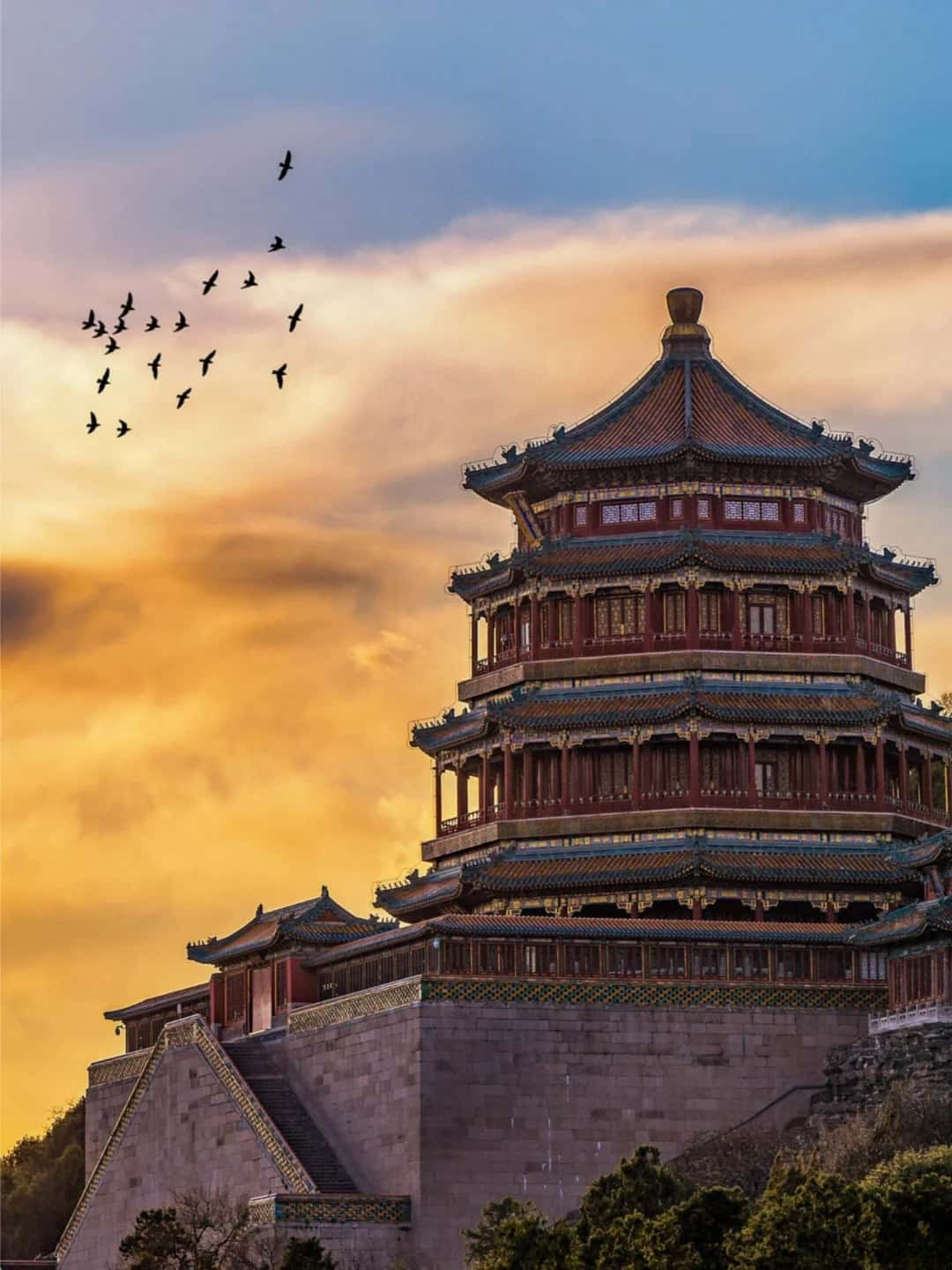
แผนที่พระราชวังฤดูร้อน
แผนที่ย่อของพระราชวังฤดูร้อน ประกอบด้วย Suzhou Street, ภูเขาว่านโซ่ว, เขตสี่ทวีป, Zhihai และทะเลสาบคุนหมิง
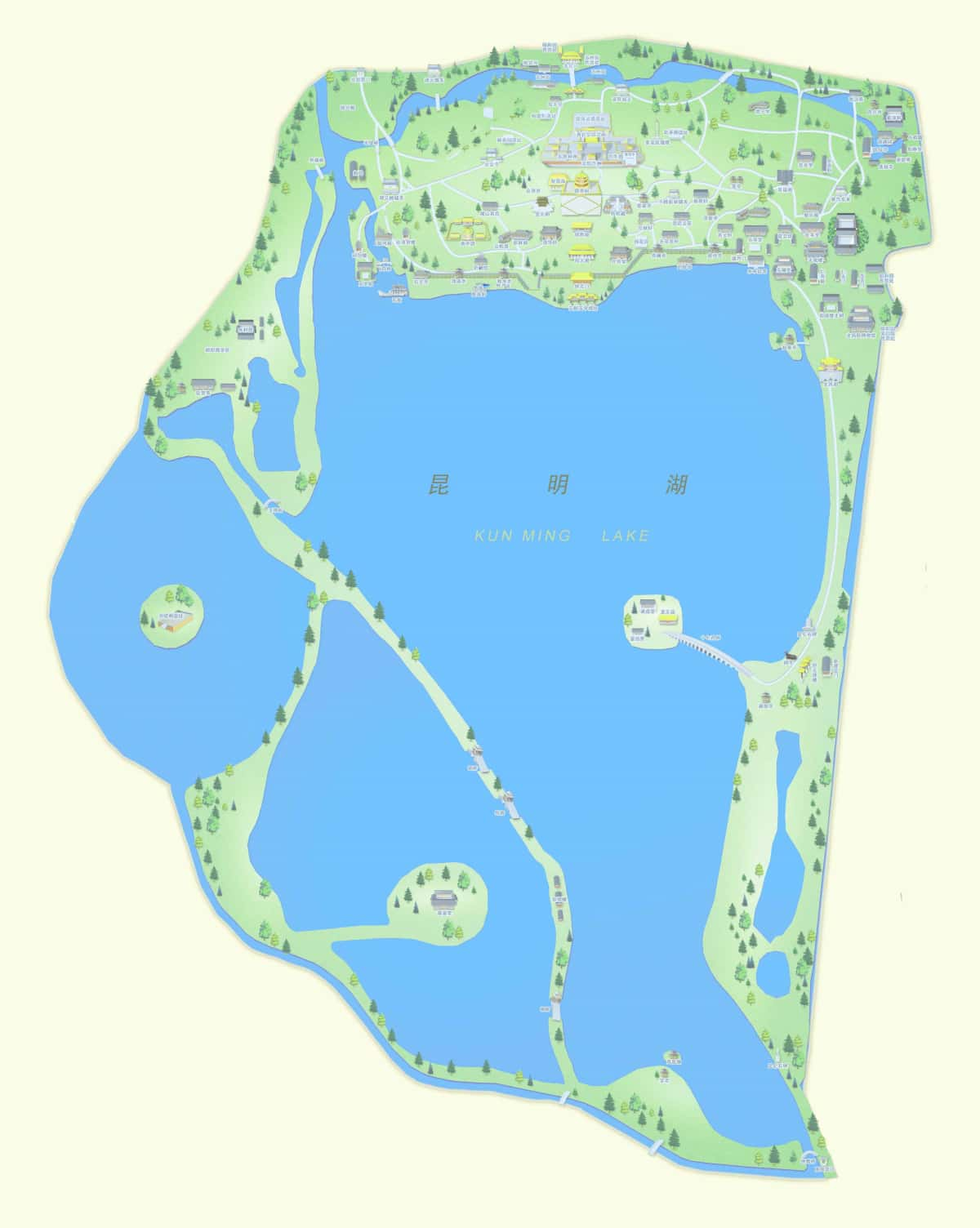
สถานที่ท่องเที่ยวหลัก 14 แห่งภายในพระราชวังฤดูร้อน
1. ถนนซูโจว
ถนนซูโจว หรือชื่อเดิมว่า “ว่านโซ่วขายซื้อถนน” ถูกสร้างขึ้นโดยจักรพรรดิเฉียนหลงซึ่งเลียนแบบบรรยากาศของเมืองน้ำทางตอนใต้ของจีน โดยมีไว้เพื่อให้จักรพรรดิและพระมเหสีเสด็จมาชมบรรยากาศตลาดโบราณ พนักงานร้านค้าส่วนใหญ่แต่งกายเป็นขันทีหรือสาวในวัง และจะเปิดร้านก็ต่อเมื่อจักรพรรดิเสด็จมาเท่านั้น ต่อมาในปี ค.ศ. 1860 ร้านค้าตามแนวชายฝั่งหลายสิบแห่งถูกไฟเผาทำลาย แต่ในปี ค.ศ. 1990 ได้รับการบูรณะใหม่ ปัจจุบันถนนซูโจวถือเป็น ตลาดโบราณภายในพระราชวังจีนเพียงแห่งเดียวที่ยังคงมีตัวอย่าง ถนนซูโจวตั้งอยู่ตอนกลางของแม่น้ำซูโจว มีความยาวประมาณ 300 เมตร ล้อมรอบด้วยน้ำสองฝั่ง มีร้านค้า 64 ห้อง ซุ้มประตู 14 แห่ง และสะพานเล็ก 8 แห่ง สองฝั่งถนนยังมีโรงน้ำชา โรงเตี๊ยม ร้านเงิน ร้านขายยา โรงรับจำนำ ร้านผ้าไหม และโรงพิมพ์หนังสือให้ชมอีกด้วย
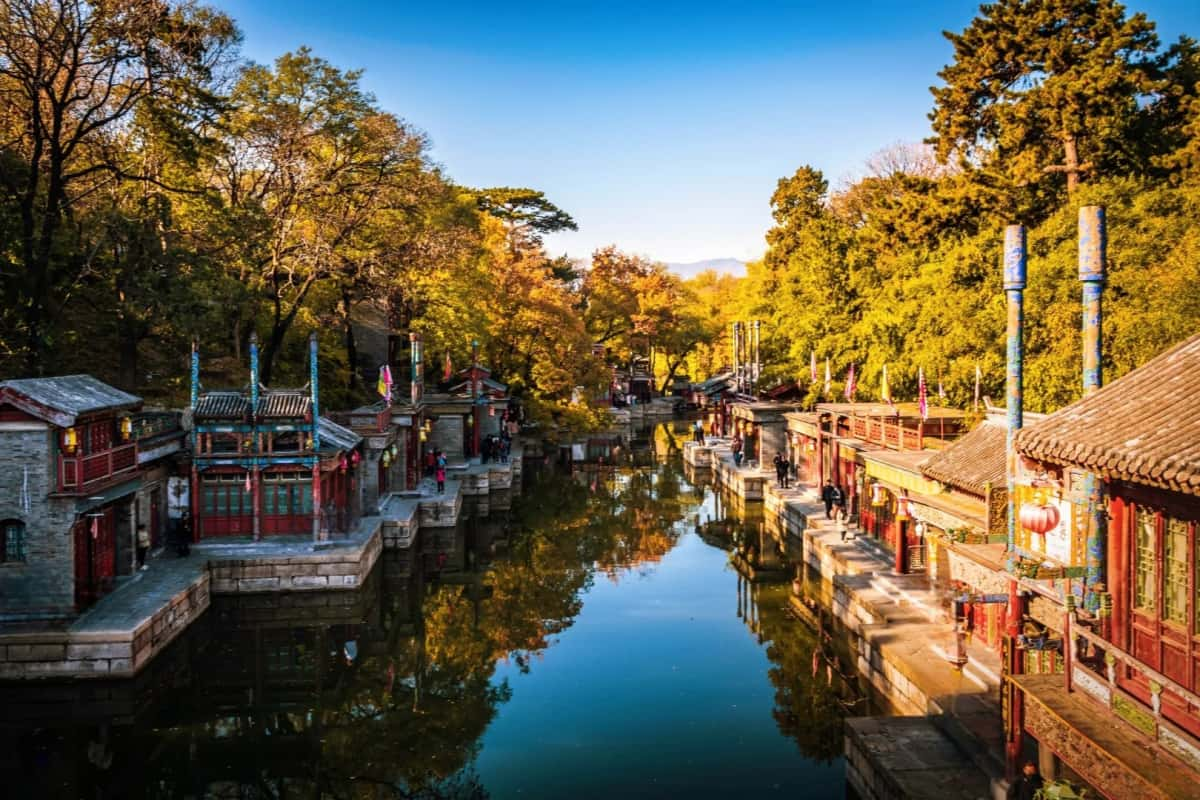
2. ภูเขาว่านโซ่ว
ภูเขาว่านโซ่วเป็นส่วนหนึ่งของเทือกเขาเยียนซาน มีความสูง 58.59 เมตร กลุ่มอาคารทั้งหมดสร้างตามแนวภูเขา โดยมี วิหารพระพุทธธูป (Fóxiāng Gé) ที่มีสามชั้น แปดเหลี่ยม และสี่ชั้นหลังคาเป็นศูนย์กลาง สร้างความยิ่งใหญ่ให้กับกลุ่มสถาปัตยกรรมหลัก เส้นแกนกลางของภูเขาเริ่มตั้งแต่ซุ้มประตู “หยุนฮุยอวี่อวี่” ผ่านประตูไพหยุน ศาลาไพหยุน ศาลาเต๋อฮุย และวิหารพระพุทธธูป ไปจนถึง “จื้อฮุ่ยไห่” ที่ยอดเขา
ทางด้านตะวันออกมีเจดีย์เก็บพระคัมภีร์และศิลาจารึก “ว่านโซ่วซานคุนหมิงหู” ด้านตะวันตกมีศาลาห้าทิศและศาลาเป่าอวิ๋น ด้านหลังภูเขามีสถาปัตยกรรมพุทธศิลป์แบบทิเบต รวมถึงเจดีย์เคลือบกระเบื้องหลากสี นอกจากนี้ยังมีศาลาและอาคารเล็ก ๆ กระจายอยู่ทั่วทั้งภูเขา เช่น ศาลาเจี้ยฝู ศาลาฉงชุ่ย ศาลาเขียนใบไม้ร่วง และศาลาภาพในภาพ
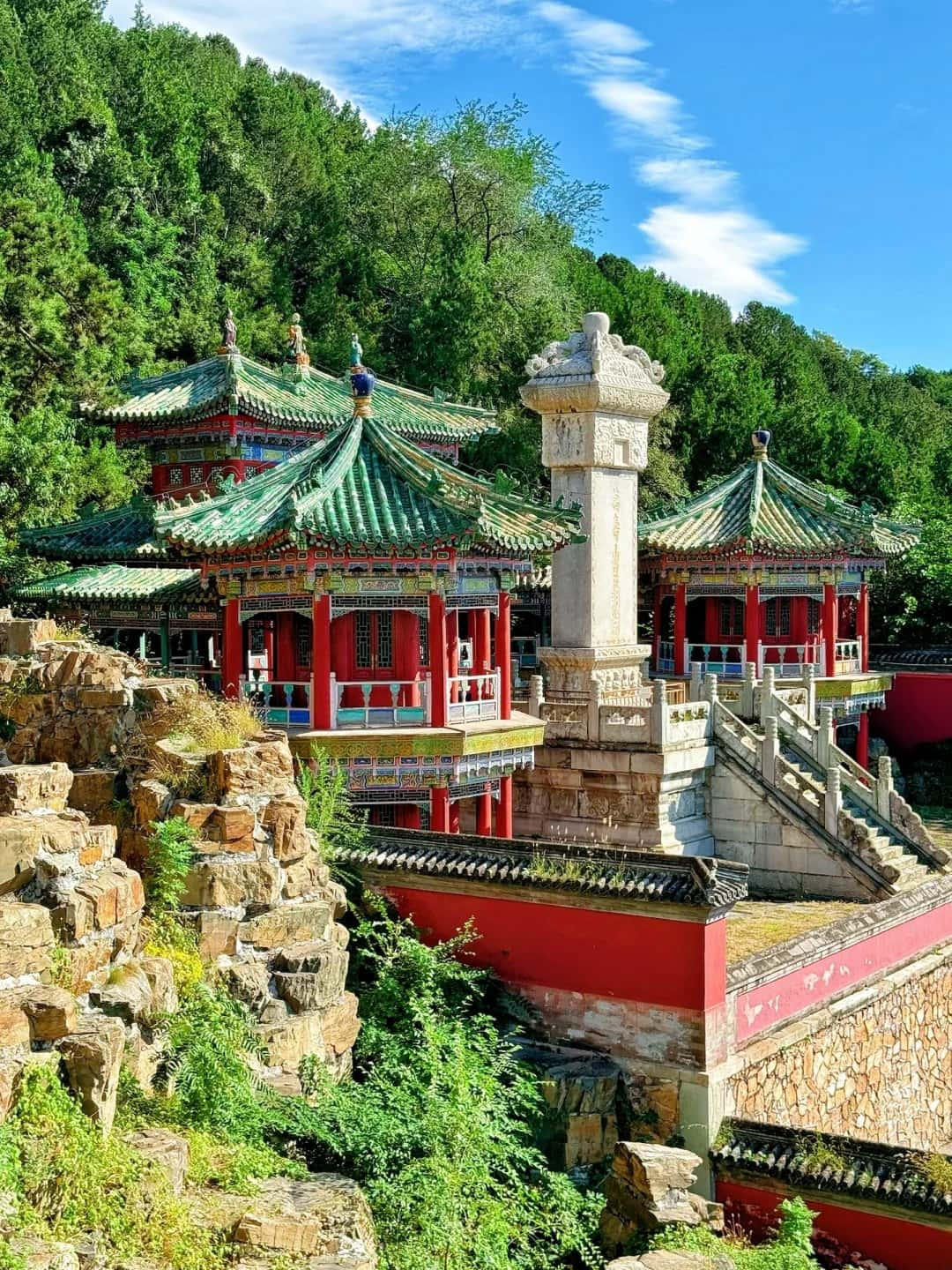
3. สี่ทวีปใหญ่ (Sì Dà Bù Zhōu)
ตั้งอยู่บริเวณด้านหลังของภูเขาว่านโซ่ว ครอบคลุมพื้นที่ประมาณ 20,000 ตารางเมตร เป็นกลุ่มสถาปัตยกรรมที่ผสมผสานสไตล์จีนและทิเบต ด้านหน้าเป็นแท่นสูง “ซูหมี่หลิงจิ้ง” ข้าง ๆ มีเสาหินสูง 3 เมตร ส่วนด้านหลังคืออาคารหลัก “เซียงเอี้ยนจงอิ้นจือเก๋อ” รอบ ๆ อาคารเป็นสัญลักษณ์ของโลกพุทธศาสนา 4 ทวีป ได้แก่ ตงเซิ่งเสินโจว, ซีหนิวฮั่วโจว, หนานซานปู้โจว และเป่ยจวี่หลูโจว รวมถึงเกาะย่อย 8 เกาะ นอกจากนี้ยังมีเจดีย์ลามะ 4 องค์สีแดง ขาว ดำ และเขียว ซึ่งเป็นสัญลักษณ์ของ “ปัญญา 4 ประการ” ของพระพุทธศาสนา เจดีย์แต่ละองค์มี 13 ชั้นแทน “สิบสามฟ้า” ตามคัมภีร์พุทธ ลักษณะเจดีย์端庄และงดงามมาก
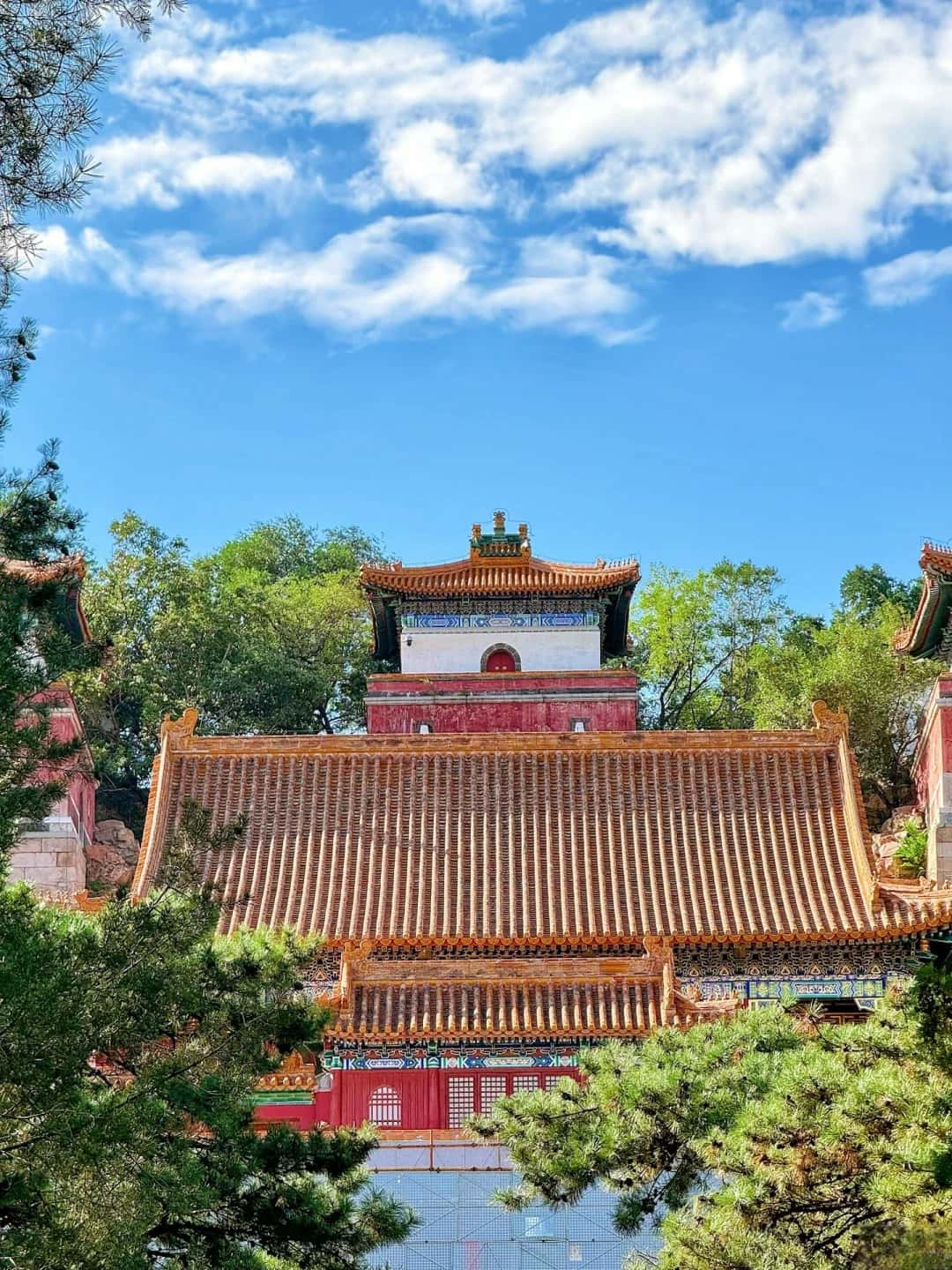
4. จื้อฮุ่ยไห่ (Zhìhuì Hǎi)
จื้อฮุ่ยไห่ตั้งอยู่บนยอดภูเขาว่านโซ่ว เป็นหอพระพุทธแบบไร้คาน ทำจากอิฐและหินทั้งหมด ใช้โครงสร้างซุ้มโค้งแบบพิเศษ ผนังภายนอกประดับด้วยกระเบื้องเคลือบสีเหลืองและเขียว พร้อมตกแต่งด้วยสีน้ำเงินและม่วงบางส่วน ด้านนอกยังประดับด้วยพระพุทธรูปเคลือบกว่าพันองค์ “จื้อฮุ่ยไห่” หมายถึง ปัญญาของพระพุทธดุจมหาสมุทร ไม่มีที่สิ้นสุด ภายในประดิษฐานพระอมิตายุส จึงเรียกว่า “อู๋เหลียงเตี้ยน” หรือหอพระไร้คานเช่นกัน
5. วิหารพระพุทธธูป (Fóxiāng Gé)
ตั้งอยู่บริเวณหน้าภูเขาว่านโซ่ว บนแท่นสี่เหลี่ยมสูง 21 เมตร ตัวอาคารสูง 41 เมตร มีลักษณะ 8 เหลี่ยม 3 ชั้น 4 หลังคา ภายในมีเสาไม้เหล็กหนา 8 ต้นค้ำยัน ถือเป็น สุดยอดสถาปัตยกรรมจีนโบราณ เดิมทีถูกไฟไหม้ในปี ค.ศ. 1860 และได้รับการบูรณะใหม่ในปี ค.ศ. 1891 เสร็จสมบูรณ์ในปี ค.ศ. 1894 นับเป็นโครงการใหญ่ที่สุดของพระราชวังฤดูร้อน ภายในประดิษฐานพระพุทธเพื่อการสวดมนต์และถวายเครื่องหอมโดยราชสำนัก
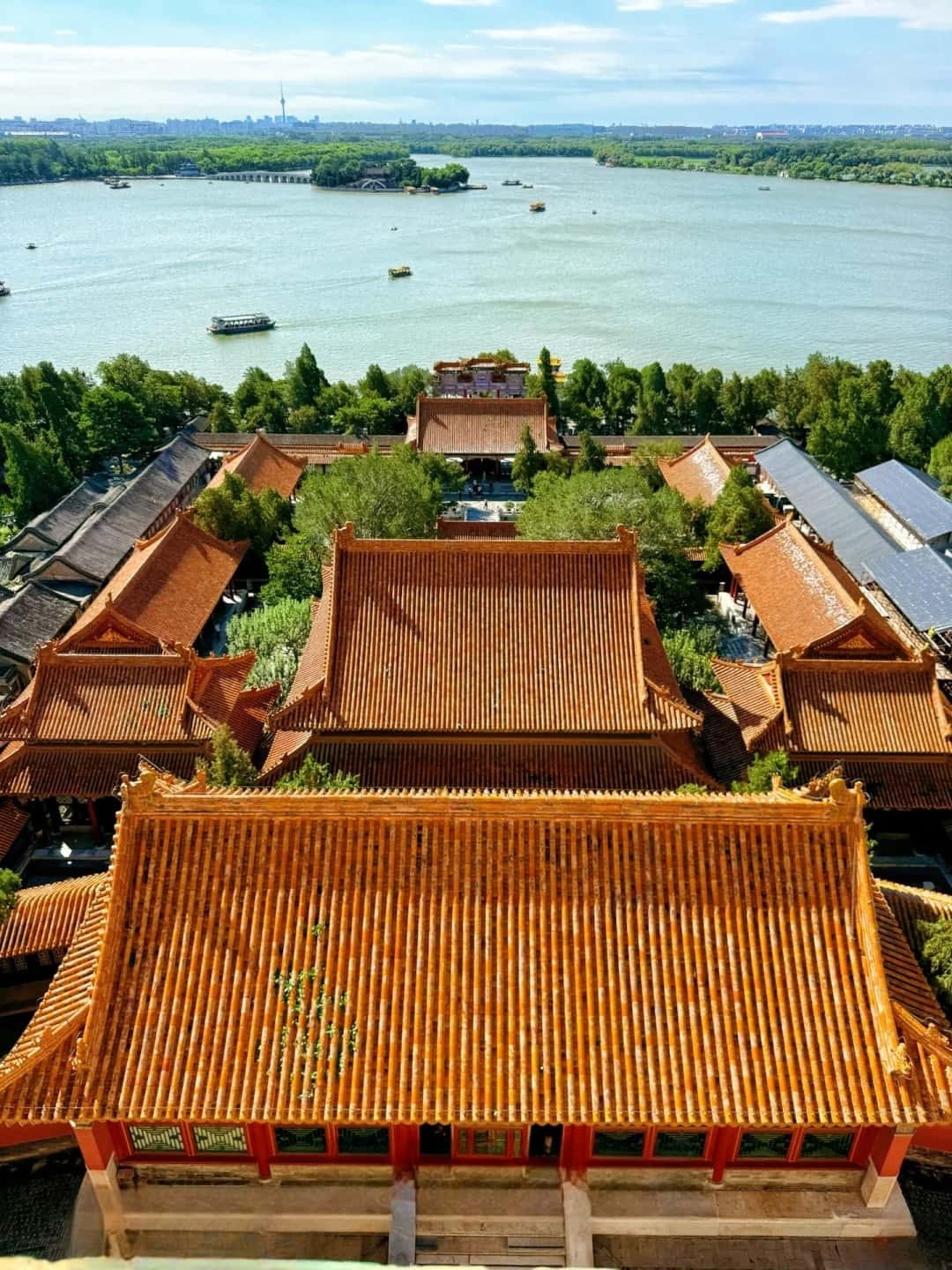
6. ศาลาเป่าอวิ๋น (Bǎoyún Gé)
หรือที่เรียกว่า “ศาลาทองสัมฤทธิ์” เป็นหนึ่งในงานหล่อทองสัมฤทธิ์ที่ใหญ่และประณีตที่สุดของจีน ตั้งอยู่ทางตะวันตกของวิหารพระพุทธธูป สูง 4 เมตร ฐานทำจากหินอ่อนขาว ตัวศาลาทั้งหมดสูง 7.5 เมตร น้ำหนักกว่า 207 ตัน ถึงแม้จะทำจากทองสัมฤทธิ์ทั้งหมด แต่โครงสร้างยังคงเลียนแบบอาคารไม้ มีประตู 3 ด้าน และหน้าต่างบาน格子ทางทิศเหนือ
7. ศาลาไพหยุน (Páiyún Diàn)
ตั้งอยู่ด้านหน้าภูเขาว่านโซ่ว เป็นหนึ่งในกลุ่มสถาปัตยกรรมที่ยิ่งใหญ่ที่สุด เดิมทีจักรพรรดิเฉียนหลงสร้างขึ้นเพื่อฉลองวันเกิดครบรอบ 60 ปีของพระมารดา ต่อมาจึงได้รับการบูรณะโดยพระนางซื่อสี่และเปลี่ยนชื่อเป็นศาลาไพหยุน ใช้เป็นสถานที่พำนักและจัดงานเฉลิมฉลอง ชื่อ “ไพหยุน” มาจากบทกวีที่หมายถึง เหมือนเทพเจ้าที่ปรากฏออกมาจากหมู่เมฆ กลุ่มอาคารนี้เมื่อมองจากระยะไกลดูราวกับพระราชวังสวรรค์
8. ทะเลสาบคุนหมิง (Kunming Lake)
เป็นหัวใจสำคัญของพระราชวังฤดูร้อน ครอบคลุมพื้นที่กว่า 220 เฮกตาร์ หรือสามในสี่ของพื้นที่ทั้งหมด ถือเป็นทะเลสาบที่ใหญ่ที่สุดในสวนหลวงสมัยราชวงศ์ชิง น้ำใสสะท้อนภูเขาทางทิศตะวันตกและศาลาทางทิศเหนือ ภายในมีสะพานสิบเจ็ดโค้งที่เชื่อมต่อกับเกาะกลางน้ำ 3 เกาะ ได้แก่ เกาะหนานหู เกาะจื้อจิ้งเก๋อ และเกาะเจ้าเจี้ยนถัง แต่ละเกาะมีอาคารโบราณที่งดงาม นักวิชาการยืนยันว่าทะเลสาบคุนหมิงมีประวัติยาวนานกว่า 3,500 ปี และถือเป็นแหล่งน้ำที่สำคัญของพระราชวังจีนหลายยุค
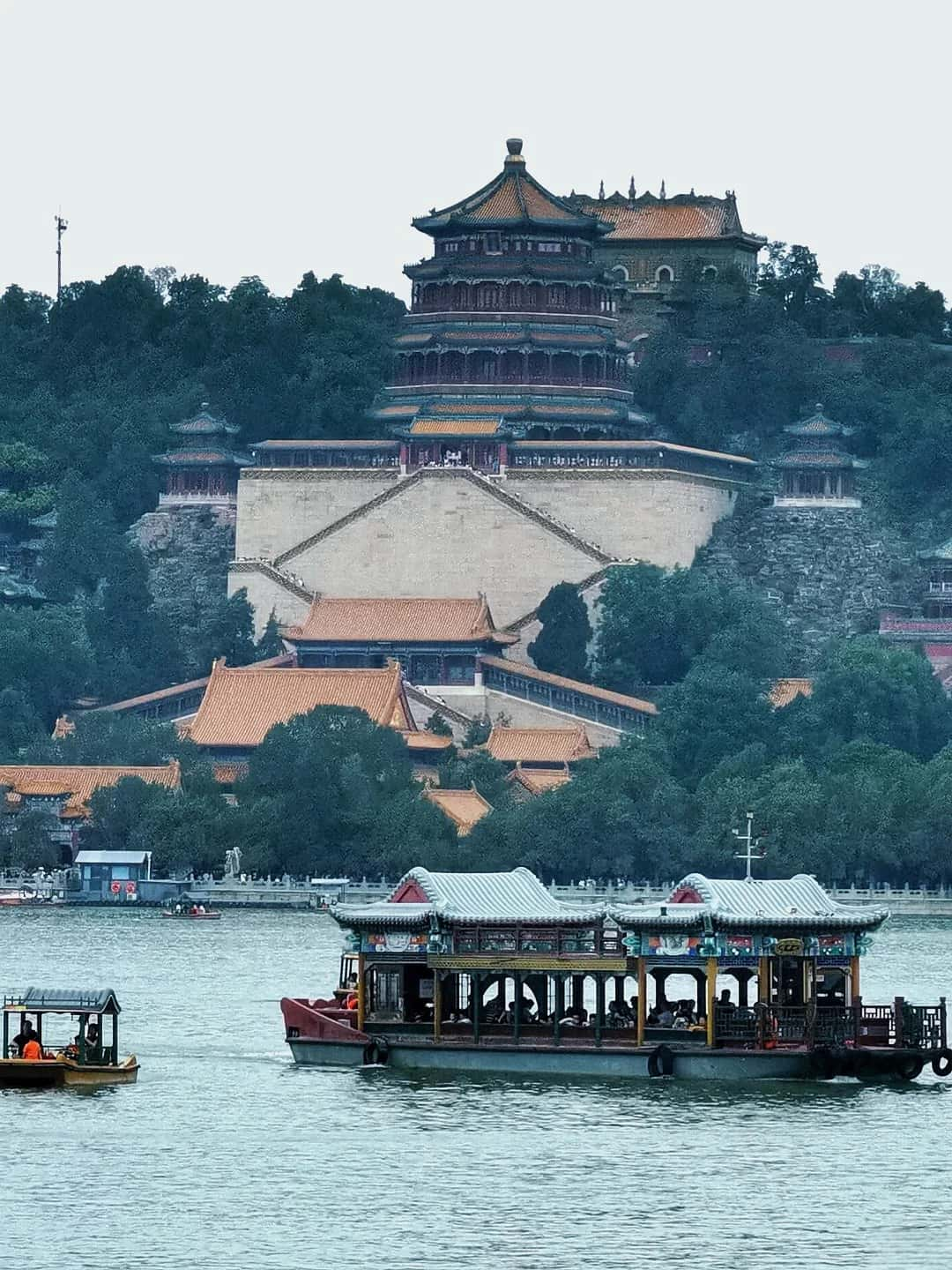
9. ศาลาเหรินโซ่ว (Rénshòu Diàn)
เดิมชื่อว่าศาลาฉินเจิ้ง สร้างขึ้นในปี ค.ศ. 1750 แต่ถูกไฟไหม้ในปี ค.ศ. 1860 ก่อนจะได้รับการบูรณะใหม่ในปี ค.ศ. 1886 และเปลี่ยนชื่อเป็นศาลาเหรินโซ่ว ชื่อมาจากคำว่า “仁者寿” ในคัมภีร์ขงจื้อ หมายถึง “ผู้มีคุณธรรมย่อมอายุยืน” ศาลานี้ตั้งอยู่ใกล้ประตูตะวันออก เป็นสถานที่ที่จักรพรรดิราชวงศ์ชิงใช้ว่าราชการ
10. ศาลาอวี่หลัน (Yùlán Táng)
ตั้งอยู่ทางตะวันตกเฉียงใต้ของศาลาเหรินโซ่ว ติดกับทะเลสาบคุนหมิง เป็นอาคารแบบลานสามด้าน มีห้องหลักหันหน้าไปทางทิศใต้ เชื่อมต่อกับศาลาเหรินโซ่วทางทิศตะวันออก และท่าเรือทางทิศตะวันตก ศาลานี้เคยเป็นที่พำนักของจักรพรรดิกวงซวีหลังถูกพระนางซื่อสี่กักขังในปี ค.ศ. 1898
11. ศาลาเล่อโซ่ว (Lèshòu Táng)
เป็นอาคารพักอาศัยหลักของพระราชวังฤดูร้อน เดิมสร้างขึ้นในปี ค.ศ. 1750 แต่ถูกทำลายในปี ค.ศ. 1860 และสร้างใหม่ในปี ค.ศ. 1887 ตั้งอยู่ริมทะเลสาบคุนหมิง โดยมีภูเขาว่านโซ่วอยู่ด้านหลัง ด้านหน้ามีท่าเรือสำหรับพระนางซื่อสี่ ชื่อศาลาเขียนโดยจักรพรรดิกวงซวีเอง บริเวณลานประดับด้วยกวางทองสัมฤทธิ์ นกกระเรียนทองสัมฤทธิ์ และแจกันทองสัมฤทธิ์ ซึ่งเป็นสัญลักษณ์ของ “ความสงบสุข”
12. ระเบียงยาว (Cháng Láng)
ตั้งอยู่เชิงเขาว่านโซ่ว หันหน้าออกสู่ทะเลสาบคุนหมิง มีความยาว 728 เมตร รวม 273 ห้อง ถือเป็นระเบียงยาวที่สุดในสวนจีน ได้รับการบันทึกในกินเนสส์เวิลด์เรคคอร์ดในปี ค.ศ. 1992 ภายในประดับภาพวาดกว่า 14,000 ภาพ ครอบคลุมภูมิทัศน์ ธรรมชาติ และฉากจากวรรณกรรมจีน
13. สะพานสิบเจ็ดโค้ง (Shíqī Kǒng Qiáo)
สะพานหินที่ใหญ่ที่สุดในพระราชวังฤดูร้อน มีความยาว 150 เมตร กว้าง 8 เมตร ประกอบด้วย 17 ช่องโค้ง ราวสะพานทั้งสองข้างมีสิงโตหินแกะสลักกว่า 500 ตัว ทำให้สะพานนี้มีความงดงามและเป็นจุดชมวิวสำคัญ
14. ศาลาเหวินชาง (Wénchāng Gé)
เดิมเป็นป้อมปราการ หนึ่งในหกป้อมของพระราชวังฤดูร้อน สร้างขึ้นในปี ค.ศ. 1750 ถูกไฟไหม้ในปี ค.ศ. 1860 และบูรณะใหม่ในรัชสมัยจักรพรรดิกวงซวี ตัวอาคารมีสองชั้น ประดิษฐานพระวินชางทองสัมฤทธิ์และรูปสำริดของเทพ รวมถึงล่อทองสัมฤทธิ์ ศาลานี้มีรูปทรงตัว “人” แสดงถึงความกลมกลืนระหว่างฟ้า ดิน และมนุษย์
พระราชวังฤดูร้อนทั้งสี่ฤดู
ฤดูใบไม้ผลิ
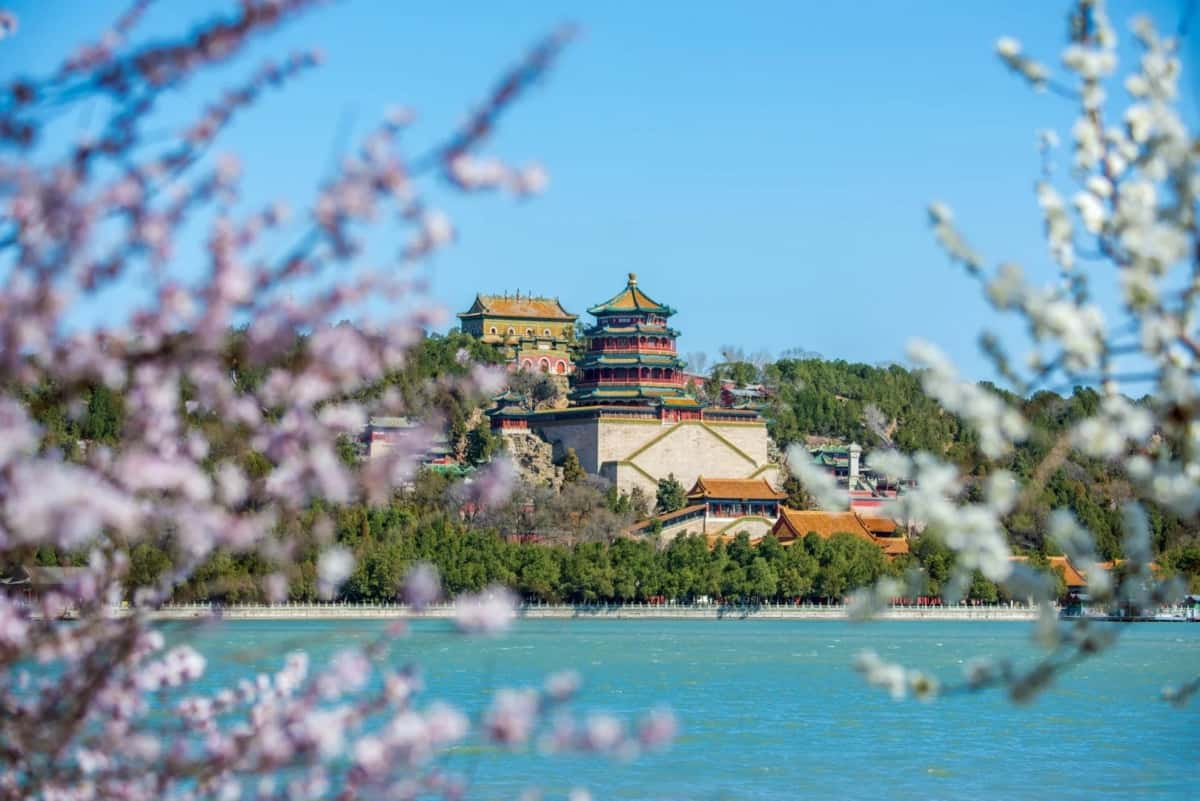
ในฤดูใบไม้ผลิ พระราชวังฤดูร้อนจะเต็มไปด้วยดอกไม้นานาชนิดที่เบ่งบาน ไม่ว่าจะเป็นดอกแมกโนเลียหรือดอกโบตั๋น ทำให้ที่นี่เป็นช่วงเวลาที่ดีที่สุดในการชมความงามของธรรมชาติ
ฤดูร้อน
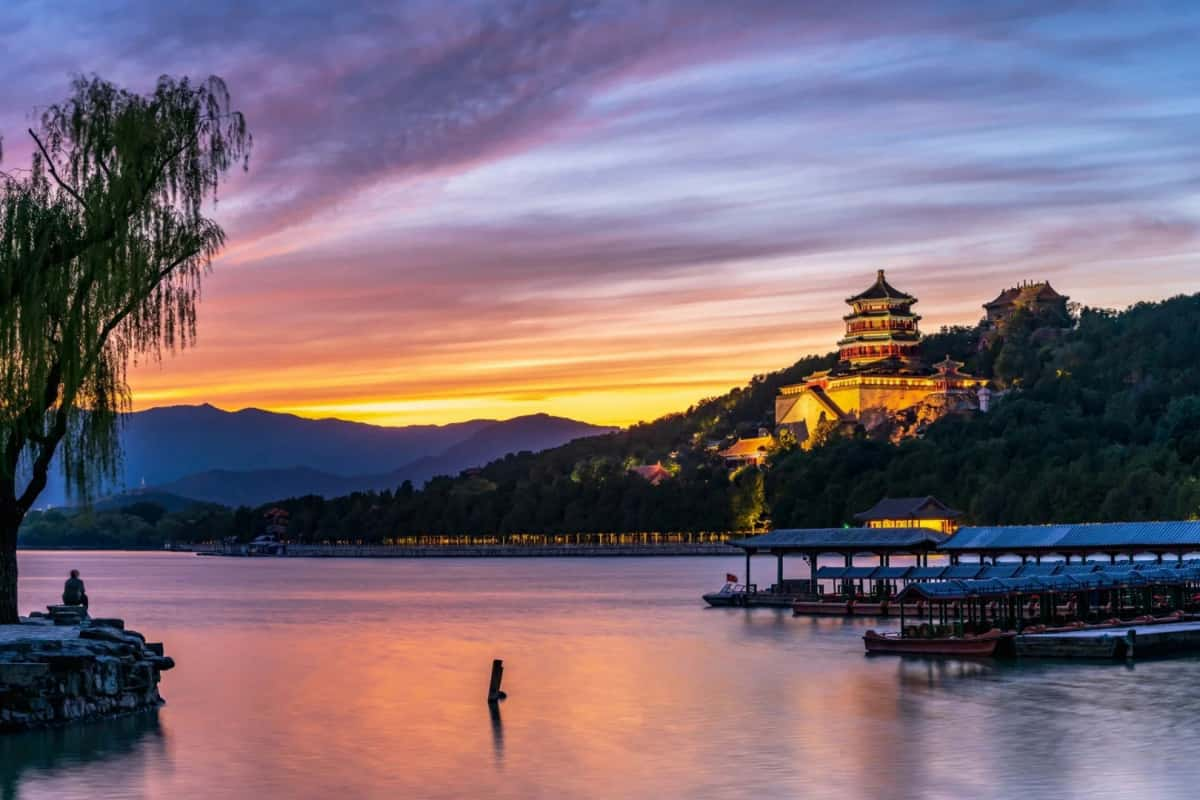
ฤดูร้อนที่ทะเลสาบคุนหมิง น้ำระยิบระยับและลมเย็นพัดเอื่อย นักท่องเที่ยวสามารถล่องเรือชมวิวในทะเลสาบ เพลิดเพลินไปกับบรรยากาศเย็นสบายของฤดูร้อน
ฤดูใบไม้ร่วง
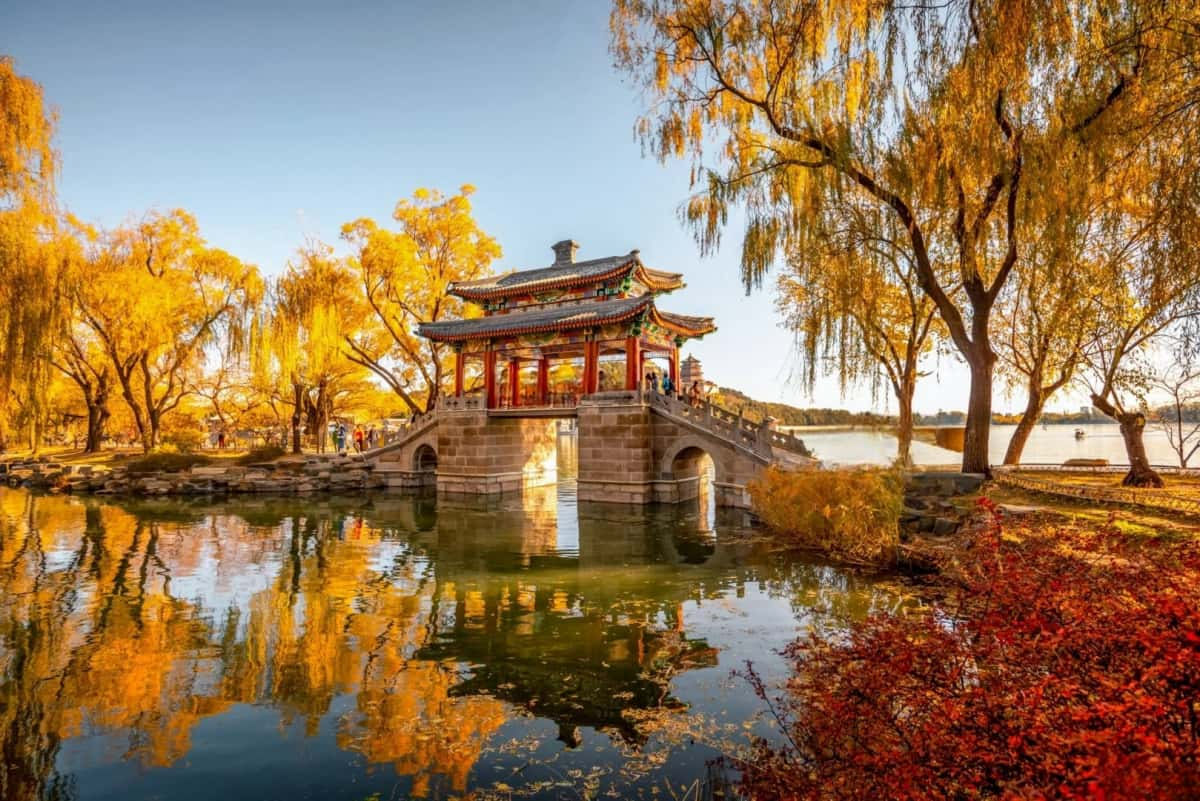
ฤดูใบไม้ร่วงของพระราชวังฤดูร้อนจะถูกแต่งแต้มไปด้วยใบไม้สีแดงทั่วภูเขา เมื่อตัดกับน้ำและภูเขารอบ ๆ ยิ่งทำให้บรรยากาศสวยงามและแสดงถึงเสน่ห์ของสวนหลวงในฤดูใบไม้ร่วง
ฤดูหนาว
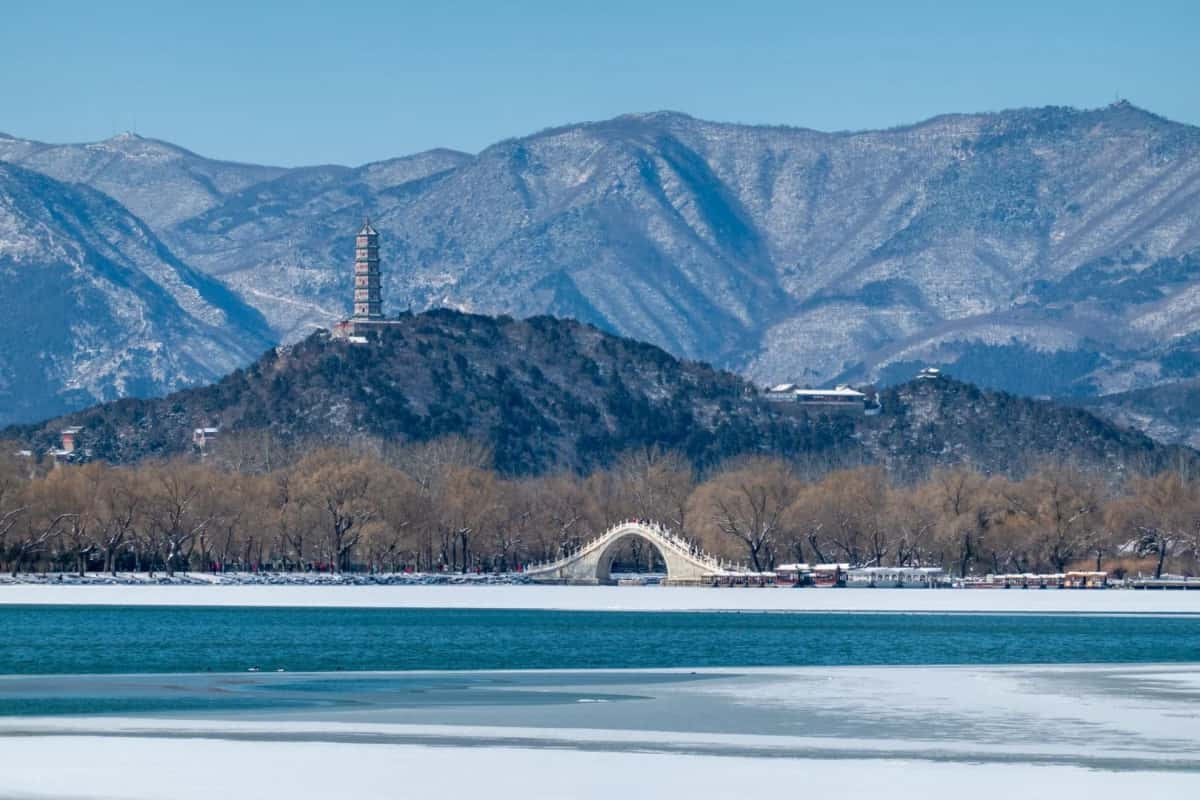
ในฤดูหนาว พระราชวังฤดูร้อนถูกปกคลุมไปด้วยหิมะขาวโพลน ศาลาพระพุทธธูป (Fóxiāng Gé) เมื่ออยู่ท่ามกลางหิมะ ยิ่งทำให้ดูสง่างามและเงียบขรึมมากขึ้น
คู่มือท่องเที่ยวพระราชวังฤดูร้อน
คู่มือการซื้อตั๋ว
- เวลาเปิดทำการ:
- ฤดูท่องเที่ยว (1 เมษายน – 31 ตุลาคม): เปิดเวลา 06:00 น. ปิดรับนักท่องเที่ยวเวลา 17:00 น. และปิดสวนเวลา 20:00 น.
- ฤดูโลว์ซีซั่น (1 พฤศจิกายน – 31 มีนาคม): เปิดเวลา 06:30 น. ปิดรับนักท่องเที่ยวเวลา 16:30 น. และปิดสวนเวลา 19:00 น.
- ราคาตั๋ว: ไม่จำเป็นต้องจองล่วงหน้า สามารถซื้อตั๋วได้ที่หน้าทางเข้า
- ตั๋วเข้าสวนพระราชวังฤดูร้อน (แนะนำ): ฤดูท่องเที่ยว 30 หยวน/คน ฤดูโลว์ซีซั่น 20 หยวน/คน เด็กอายุต่ำกว่า 6 ปี และผู้สูงอายุเกิน 60 ปีเข้าฟรี
- ตั๋วรวมพระราชวังฤดูร้อน: ฤดูท่องเที่ยว 60 หยวน ฤดูโลว์ซีซั่น 50 หยวน รวมเข้าชมสวน Deheyuan, ศาลาพระพุทธธูป, ถนนซูโจว และพิพิธภัณฑ์พระราชวังฤดูร้อน
สินค้าแนะนำ: พระราชวังฤดูร้อนคือ สวนหลวงโบราณที่ต้องไปเยือนเมื่อเที่ยวปักกิ่ง /คลิกที่นี่เพื่อซื้อตั๋วพระราชวังฤดูร้อน/ ให้การเดินทางของคุณราบรื่นยิ่งขึ้น!
ตั๋วเรือในพระราชวังฤดูร้อน
ออดิโอไกด์อิเล็กทรอนิกส์:
- ราคา: 40 หยวน มัดจำเพิ่ม 50 หยวน คืนอุปกรณ์ได้ทุกทางเข้า (ยกเว้นทางตะวันตก)
- มีให้บริการ 19 ภาษา รวมถึงภาษาอังกฤษ ฝรั่งเศส และเยอรมัน
สินค้าแนะนำ: หากต้องการเรียนรู้ประวัติศาสตร์และวัฒนธรรมของพระราชวังฤดูร้อนอย่างลึกซึ้ง การจองทัวร์พร้อมไกด์นำเที่ยว คือทางเลือกที่ดีที่สุด /จองทัวร์พระราชวังฤดูร้อน+ไกด์มืออาชีพ/ เพื่อไม่พลาดจุดสำคัญในสวนหลวง
คู่มือการเดินทางจากตัวเมืองปักกิ่งไปพระราชวังฤดูร้อน
- รถไฟใต้ดิน: นั่งสาย 4 ไปลงที่สถานี Beigongmen (北宫门) ออกทาง C ก็ถึงพระราชวังฤดูร้อน
- รถบัส: สาย 303, 331, 332, 346, 384, 394, 563, 584, 594, 601, 夜8 และสายท่องเที่ยว 3 ไปถึงหน้าประตู Beigongmen เดินไม่กี่นาทีก็เข้าสวนได้
เส้นทางท่องเที่ยวแนะนำ
- เส้นทาง 2 ชั่วโมง: เข้าทางประตู Nán Rúyìmén หรือ Xinjian Gongmen นั่งเรือชมทะเลสาบคุนหมิง ผ่านศาลาเล่อโซ่วและศาลาเหรินโซ่ว ออกทางประตูตะวันออก เน้นชมวิวทะเลสาบ ใช้เวลาเพียง 1.5 ชั่วโมงหากจัดเวลาได้ดี
- เส้นทาง 3 ชั่วโมง: เข้าทางเดียวกัน นั่งเรือชมเรือหิน ศาลาภาพในภาพ ระเบียงยาว ศาลาไพหยุน ศาลาเล่อโซ่ว ศาลาเหรินโซ่ว และออกทางประตูตะวันออก เป็นเส้นทางเดินเล่นที่ไม่เหนื่อยนัก ยกเว้นจุดศาลาภาพในภาพที่ต้องเดินขึ้นเล็กน้อย
- เส้นทาง 4 ชั่วโมง: เข้าทาง Nán Rúyìmén หรือ Xinjian Gongmen ผ่านเรือหิน ศาลาภาพในภาพ ระเบียงยาว ศาลาไพหยุน ศาลาเล่อโซ่ว สวน Xiequ สี่ทวีปใหญ่ ถนนซูโจว ออกทางประตูเหนือ เส้นทางนี้ครอบคลุมเกือบทุกจุดไฮไลท์ แต่ต้องเดินขึ้นเขา
- เส้นทางฤดูหนาว: เนื่องจากหยุดให้บริการเรือในช่วงฤดูหนาว แนะนำเข้าทาง Xinjian Gongmen เดินชมศาลาเหรินโซ่ว ศาลาเล่อโซ่ว ศาลาไพหยุน ระเบียงยาว ศาลาภาพในภาพ เรือหิน สี่ทวีปใหญ่ และออกทางประตูเหนือ
บริการฝากกระเป๋าและรถเข็นเด็ก
แม้ว่าศูนย์บริการของพระราชวังฤดูร้อนจะไม่มีบริการฝากกระเป๋า แต่ร้านค้าหน้าสวนมีบริการดังนี้:
- กระเป๋าเดินทางใบใหญ่: 40 หยวน ใบเล็ก: 30 หยวน เป้สะพาย: 20 หยวน
- ใกล้สถานีรถไฟใต้ดิน Beigongmen ทางออก D มีจุดฝากกระเป๋าและให้เช่ารถเข็นเด็ก-รถเข็นผู้สูงอายุ
- ทางออก C เดินตรง 50 เมตร ข้ามไฟแดงอีก 100 เมตร จะมีร้าน “Jiuchasheng” ให้บริการฝากกระเป๋าเช่นกัน
ร้านอาหารแนะนำ
- Fangzhuanchang 69 Zhájiàngmiàn (สาขา Xinyuehui พระราชวังฤดูร้อน): ที่อยู่ เลขที่ 208 ถนนพระราชวังฤดูร้อน ชั้น 1 อาคาร A ศูนย์การค้า Longhu Xinyuehui ร้านนี้เสิร์ฟบะหมี่หมูสับสูตรเก่าแก่ที่ได้รับการแนะนำโดยมิชลิน เมนูแนะนำคือ บะหมี่หมูสับแบบปักกิ่งแท้ ๆ รวมถึงเครื่องเคียงแบบโบราณ
- Tingliguan Restaurant (สาขาพระราชวังฤดูร้อน): ร้านอาหารเก่าแก่ในสวน บรรยากาศจีนโบราณ เมนูยอดนิยมได้แก่ ขนมวังหลวงและเป็ดปักกิ่ง
คำถามที่พบบ่อย
ไม่จำเป็น สามารถซื้อตั๋วได้ที่หน้าทางเข้าโดยตรง
ศูนย์บริการหลักไม่มีบริการ แต่มีร้านค้าเล็ก ๆ ใกล้ประตูทางเข้าที่ให้ฝากกระเป๋าได้ เช่น ทางออก D ของสถานี Beigongmen และร้าน Jiuchasheng ใกล้ทางออก C
รวมลิงก์แนะนำเที่ยวปักกิ่งที่จำเป็น
- คู่มือเที่ยวปักกิ่งฉบับสมบูรณ์ 📖
- แนะนำสถานที่ท่องเที่ยวและแผนเที่ยวปักกิ่ง🏙️
- แนะนำที่พัก 🏨
- คู่มือการเดินทาง ✈️ 🚇 🚄 🚆
- เคล็ดลับและข้อมูลจำเป็นในการท่องเที่ยว 🗺️ 🍜 📱 💸 🌤️ 💊
- 🗺️ แผนที่ปักกิ่ง
- 🍜 แนะนำอาหารอร่อยในปักกิ่ง
- 🍜 คู่มือร้านเป็ดปักกิ่ง
- 📱 แอปพลิเคชันจำเป็นสำหรับการท่องเที่ยว
- 💸 คู่มือขอคืนภาษี (Tax Refund) ในจีน
- 🌤️ ข้อมูลสภาพอากาศปักกิ่ง
- 💊 รายการยาจำเป็นที่ควรนำไปเที่ยวจีน
- 🛍️ ดีลท่องเที่ยวในประเทศจีน
- 🔌 ปลั๊กจีน แรงดันไฟฟ้า และคู่มือปลั๊กไฟจีน
- 📶 วิธีการใช้ eSIM ในประเทศจีน
- 🧳 รายการบรรจุภัณฑ์และเช็คลิสต์การเดินทาง

 English (US)
English (US)  繁體中文
繁體中文 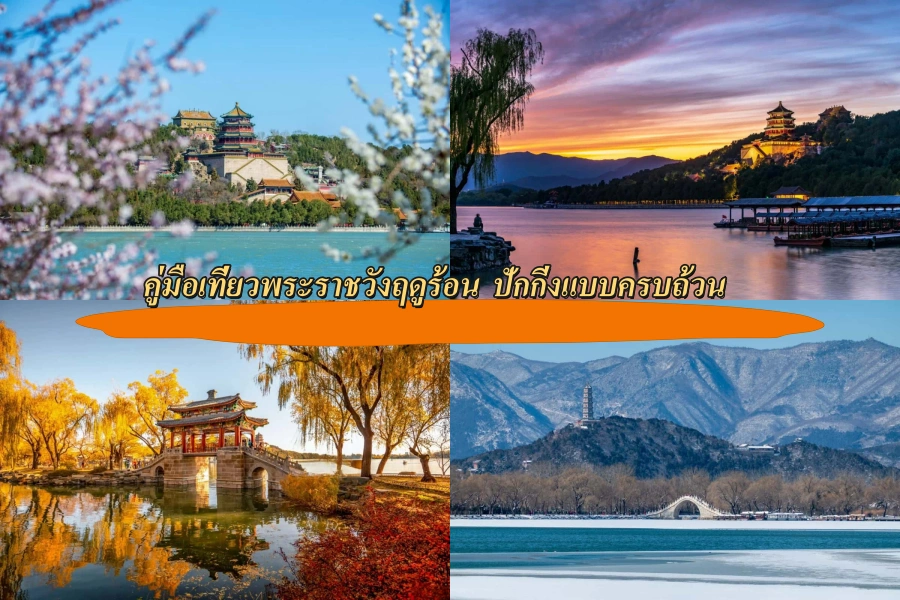
Comment (0)